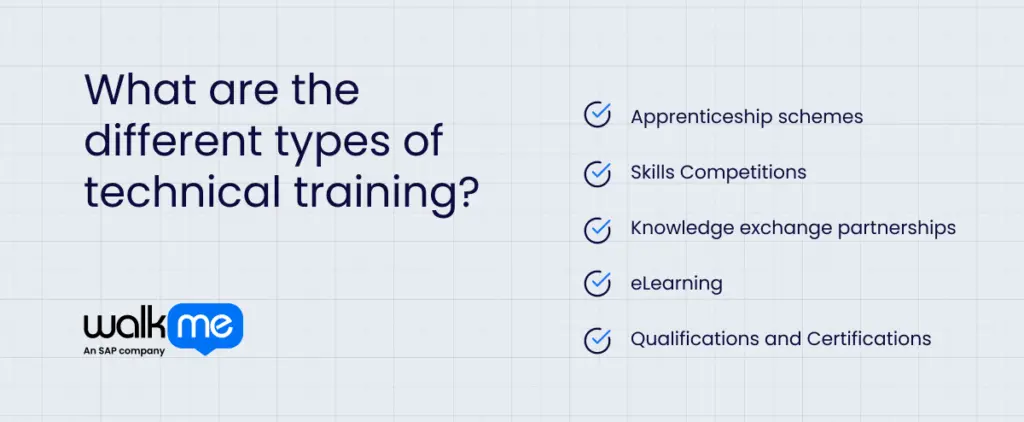Technical training is a type of employee training focused on developing specific skills required for technical tasks, such as programming, system management, and design.
Weaknesses in technical training contribute significantly to the global talent shortage. Companies struggling to find employees with essential technical skills in programming, security, and design face serious growth limitations.
Nearly 41% of UK decision-makers acknowledge that the ongoing skills shortage negatively affects their organization’s productivity. This is largely due to the critical need for technical skills to drive performance and growth in today’s workforce.

This article explores how to improve technical training within your organization. It defines technical training, introduces effective training methods, and identifies when it is most useful for businesses.
What is technical training?
Technical training imparts knowledge, skills, and competencies related to a specific field or industry that involves a significant technical or technological component.
Areas where technical training is especially important include:
- Information Technology (IT)
- Engineering roles
- Trades and manual labor
- Audio, video, and media technicians
- Science and technology research (leading and supporting).
Technical training may overlap with other types of learning: advanced computer science roles, for example, require a deep theoretical understanding and practical skills. However, technical training differs from soft skills, liberal arts, or general management development.
What are the different types of technical training?

Companies today deliver technical education through many familiar employee training methods. However, technical training works well with techniques that use highly practical learning experiences.
In this section, we will introduce some of the most interesting forms of technical training. They include:
- Apprenticeship schemes
- Skills Competitions
- Knowledge exchange partnerships
- eLearning
- Qualifications and Certifications
We will explain these training methods, how to implement them, and who they aim for.
Apprenticeship schemes
An apprenticeship program combines on-the-job and off-the-job training to equip individuals with a comprehensive skill set.
While traditional apprenticeships focus on trades like carpentry or plumbing, modern ones extend to fields such as data science, marketing, and software development.
These programs provide a practical career path, offering hands-on experience and a wage, while bridging the gap between education and employment.
How to implement it
If you’re thinking about implementing apprenticeships, make sure you consider the following steps:
- Companies rarely need to create an apprenticeship program from scratch. Start by connecting with existing programs in your industry or region.
- Check if your government offers support for business apprenticeships. Some countries also fund employee wages, easing financial burdens.
- Apprenticeships foster long-term commitment by allowing employees to grow through hands-on learning and skill development.
- These programs also support upskilling and reskilling. If your company has skill shortages, apprenticeships can effectively address critical needs.
As a recent Gartner report explains, you can “reimagine” how apprenticeships work for you. They are an adaptable training method that can resolve many skills problems.
Who’s it for?
Apprenticeships are conventionally aimed at young people who have left school without exceptional academic qualifications. They provide an opportunity to introduce a different career path. However, apprenticeships are now useful for many types of employees. For example, early-career staff with strong soft skills can learn a lot from the hands-on education of an apprenticeship.
Skills competitions and showcases
Skills competitions allow trainees to showcase their talents to staff throughout a company’s hierarchy. These events are useful for honing problem-solving and teamwork skills, which are crucial in the workplace.
While the competitive element is vital, participation is the most important learning element. Anyone who takes part will improve their skill set.
Showcases enhance skills such as communication, presentation, and networking – which may not be fully developed in classroom settings or even apprenticeships. Participation in skills competitions contributes to well-rounded employee development beyond technical expertise.
How to implement it
Skills competitions are an innovative method of training. However, you can still learn from best practices in the training sector. Think particularly about these points:
- Skills competitions involve training providers and can be adapted to an organizational setting, regardless of size.
- Output types should align with training goals, including presentations, posters, or demos.
- Staff participation is crucial, with permanent staff acting as judges, mentors, or audience members.
Who’s it for?
Skills competitions are excellent for anyone in a collective training program. They promote teamwork, encourage friendly competition, and help participants showcase their talents while reinforcing the skills learned during training.
Knowledge exchange placements
A knowledge exchange partnership involves a technical staff member undertaking a short-term placement in another organization to enhance their knowledge and skills.
This collaborative arrangement is particularly beneficial for professionals in various technical disciplines, including software development, hardware maintenance, helpdesk support, audio/visual technologies, and more.
The exchange aims to expose workers to diverse environments, fostering the acquisition of new insights, techniques, and practices. These partnerships typically occur briefly, allowing participants to stay current with industry advancements and contribute fresh perspectives to their home organization.
How to implement it
If you wonder whether a knowledge exchange placement would be right for your staff, think about these points:
- A company-led needs assessment typically drives learning interventions, but technical professionals often initiate knowledge exchange placements focused on advancing their expertise.
- Successful placements require clear learning outcomes, with a well-defined KPI guiding development.
- External organizations, like the UK’s ITSS, help facilitate the process, ensuring suitable placements.
- Regularly evaluate knowledge exchange placements by gathering feedback and assessing their impact on development and organizational goals.
- This type of training works well when your organization fosters a supportive learning culture and has technical staff who are confident in initiating knowledge exchange.
Who’s it for?
Knowledge transfer placements are often a feature of educational institutions, which are less likely to compete with one another. However, they would also be excellent for technical staff within a large company.
eLearning
eLearning is a versatile set of methods with significant technical training applications.
It’s especially useful for desk-based technical skills – programming, cybersecurity, UX, technical writing, and more. Job-seekers often turn to online platforms like Coursera to enhance their portfolio of “hard” skills, as recent WEF research discusses.
While eLearning is great for informally boosting employability, companies can also embrace it to ensure their staff has the right technical skills for tomorrow.
How to implement it
Corporate eLearning for technical training can take many forms. Think about the following points:
- eLearning offers flexible solutions to organizational needs. They can include widespread technical upskilling but also be highly niche and targeted.
- 3rd party providers can be a highly efficient approach, tapping into their specialized expertise and resources.
- Building in-house eLearning capacities provides versatility for various situations, allowing organizations to tailor training content and delivery to their unique requirements.
Who’s it for?
eLearning is valuable for employees looking to upskill or reskill, especially those aiming to change or enhance their career path. It offers flexible, self-paced learning opportunities that allow individuals to acquire new skills and knowledge tailored to their personal and professional growth, enhancing career advancement prospects.
Qualifications and certifications
Qualifications and certifications play critical roles in technical training. Certifications are more than formalities; they validate that your employees possess the practical skills and expertise to tackle complex problems.
In fields where technical issues can directly impact revenue, safety, or data privacy, having certified staff ensures they can resolve challenges effectively and efficiently.
Certifications help build confidence in one’s ability to manage high-pressure situations, ensuring that organizations are prepared to face the technical difficulties that arise in today’s fast-evolving business environment.
How to implement it
If you’re thinking about technical qualifications for your staff, think about the following points:
- Businesses are legally required to use appropriately qualified staff for some tasks. Know who needs certification and ensure they keep it up to date.
- Certification can be linked to many other types of corporate learning programs. For example, an apprenticeship may give participants a formal qualification in their area of specialization.
- Qualifications and certifications can be waymarks of continuous learning. They help distinguish between initial, intermediate, and advanced expertise in an area or a specialism within a region. Try to think of this as a long-term investment.
What are the practical applications of technical training?
In today’s competitive business environment, three key “hard skills” are essential for organizations:
- Artificial Intelligence (AI)
- Design and UX
- Cybersecurity
This section will explore how technical training can be applied in these areas and offer practical insights on implementing training programs to upskill your workforce.
Companies can strengthen their operations, improve customer experiences, and safeguard their digital infrastructure by developing expertise in AI, design, UX, and cybersecurity.
We’ll discuss strategies for effectively integrating technical training into your organization’s workflow, ensuring employees are prepared for the challenges ahead.
AI and big data
Technical training enhances an organization’s AI and big data capabilities. In the age of generative AI chatbots like ChatGPT and Bard, it’s easy to forget that AI usage is an extremely technical field. Moreover, AI raises many business problems that require highly targeted technical training.
Some of the challenging areas include:
- Navigating complex AI legal issues
- Company-wide AI adoption challenges
- Unpredictable AI security risks
- Monitoring and harnessing shadow AI usage.
Technical training provides the necessary skills and knowledge to harness the potential of these advanced technologies effectively. Training ensures that employees understand the ins and outs of AI algorithms, data processing, and analytical tools, enabling them to make informed decisions and contribute meaningfully to data-driven initiatives.
There are many practical business use cases for AI today, which creates training challenges. Even in this niche, what should you do first? Think about these steps to improve your technical AI capabilities:
- Assess AI’s role in your company. The possibilities are huge, but not everyone needs highly trained AI-ready staff.
- eLearning resources from Coursera, Harvard, MIT, and Google all provide a broad foundation in AI. Whatever your specialist needs, courses from these providers can give your staff the basic technical knowledge they need.
- Make technical training one part of a bigger strategy for AI. Building artificial intelligence capability starts with technical knowledge, but business vision is essential for long-term results.
Design and UX
Leaders often undervalue design and UX skills. Everyone knows something about layout, aesthetics, and supporting users. However, truly user-centric experiences must be created by trained professionals with a deep understanding of the risks (and possibilities) of good design.
Technical training fosters skills in design principles, user behavior, and the latest tools. It enables teams to deliver products and interfaces that meet high usability and visual appeal standards. Technical training to the right staff can ensure you meet all your UX goals.
Cybersecurity
Cybersecurity is a critical issue for businesses due to the escalating frequency and sophistication of cyber threats. The digital landscape constantly evolves, and cybercriminals employ advanced tactics to breach security measures. While it’s essential to inform employees about cybersecurity threats, it’s even more important to have staff who can handle the impact of a cybersecurity breach.
However, acquiring staff with hard skills in cybersecurity can be challenging. Traditional education may not keep up with the rapidly changing threat landscape, but technical training can equip employees with the necessary skills.
Tailored technical training programs address cybersecurity challenges, ensuring employees possess the knowledge and expertise to safeguard digital assets effectively.
Look to the future with technical skills training
Building your company’s capacity for the latest technical skills is crucial for staying competitive and future-ready. As business leaders focus on the next “big thing” in technology or engineering, they rely on their workforce to have the skills to bring these innovations to life.
Whether adopting AI, enhancing cybersecurity measures, or improving user experience, a well-trained team is key to achieving those aspirations.
With the right technical training interventions, your company can equip employees with the expertise to tackle new challenges, innovate effectively, and maintain a competitive edge in the evolving market.
FAQs
Basic technical training provides foundational knowledge and skills in specific technical fields, such as IT, programming, or machinery operation. It helps individuals develop the essential competencies required to perform technical tasks effectively in their roles, preparing them for entry-level positions or further specialized training.
Whether you’re paid for technical training depends on your employer and the training structure. Some companies offer paid training as part of employee development. In contrast, others may provide training during work hours or as part of an apprenticeship program, which includes a salary or wage.
The length of technical training varies based on the field and program. Basic courses may last a few weeks, while advanced certifications or specialized programs can take several months. Apprenticeships or formal degrees may take years, depending on the required depth of knowledge and practical experience.

